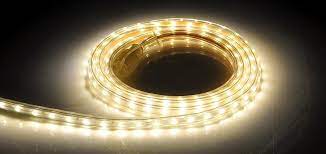LED strip lights have become a popular lighting choice for many households due to their versatility, energy efficiency, and ease of use. Compared to traditional lighting sources, such as incandescent bulbs or fluorescent tubes, LED strip lights use significantly less electricity. However, it is still important to understand how much electricity LED strip lights consume and whether they are a good choice for your home. Here’s what you need to know about the electricity consumption of LED strip lights.
How Much Electricity Do LED Strip Lights Use?
LED strip lights are highly efficient and use significantly less electricity than traditional lighting sources. The amount of electricity consumed by LED strip lights depends on several factors, including the length and brightness of the strip, the number of hours it is used per day, and the power rating of the power supply.
Most LED strip lights consume between 2 and 14 watts per foot, depending on the brightness level and color temperature. For example, a standard 16.4-foot (5-meter) roll of LED strip lights typically uses between 24 and 96 watts, depending on the brightness level. This is a fraction of the energy consumed by traditional lighting sources.
To put this in perspective, a 60-watt incandescent bulb consumes 60 watts of electricity per hour, while a 100-watt bulb uses 100 watts of electricity per hour. By contrast, a 16.4-foot roll of LED strip lights using 24 watts per foot would consume a total of 393.6 watts if used continuously for 16 hours. This is still significantly less than traditional lighting sources.
Factors Affecting LED Strip Light Electricity Consumption
Brightness Level:
The brightness level of LED strip lights affects their electricity consumption. The brighter the strip, the more electricity it will consume. However, LED strip lights are still much more energy-efficient than traditional lighting sources.
Color Temperature:
The color temperature of LED strip lights can affect their electricity consumption. For example, warm white LED strip lights typically consume less electricity than cool white or daylight LED strip lights.
Length of Strip:
The length of the LED lights will affect their electricity consumption. The longer the strip, the more electricity it will consume. However, LED strip lights are still highly energy-efficient, even when used in longer lengths.
Power Supply Rating:
The power rating of the power supply can also affect the electricity consumption of LED lights. A higher-rated power supply will be able to handle a longer strip of lights and will consume more electricity.
Benefits of Using LED Strip Lights
Energy Efficiency:
As mentioned earlier, LED lights are highly energy-efficient and use significantly less electricity than traditional lighting sources. This makes them an eco-friendly and cost-effective lighting choice for your home.
Long Lifespan:
LED strip lights have a long lifespan and can last up to 50,000 hours or more. This means you won’t have to replace them as often, reducing your overall maintenance costs. SEPCO Bill
Versatility:
LED strip lights come in a wide range of colors, brightness levels, and color temperatures. They can be used for a variety of purposes, including accent lighting, task lighting, and ambient lighting.
Easy Installation:
LED strip lights are easy to install and can be cut to fit the specific length of your space. They can be attached with adhesive backing or mounting clips and do not require any special tools or skills to install.
Low Heat Output:
LED strip lights produce very little heat, making them a safer lighting choice for your home. This also means they are less likely to cause any damage to surrounding materials or objects.
Conclusion
In conclusion, LED strip lights are a highly energy-efficient and cost-effective lighting choice for your home. While they do consume electricity, they use significantly less than traditional lighting sources, making them an eco-friendly option. Their versatility, long lifespan, easy installation, and low heat output make them an attractive lighting option for a wide range of applications.

